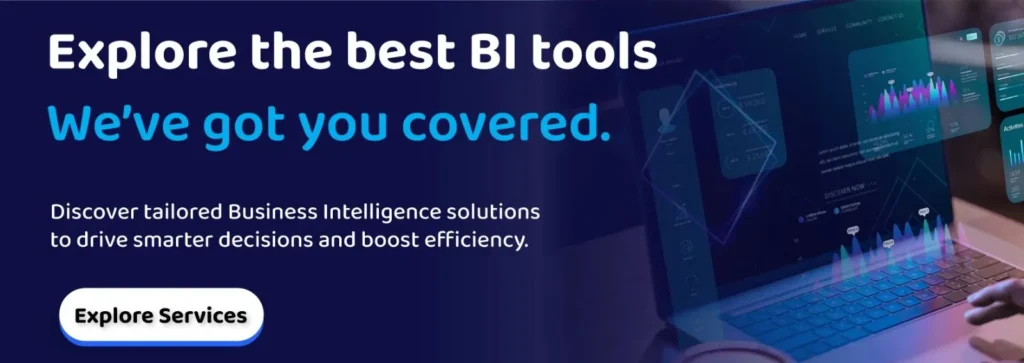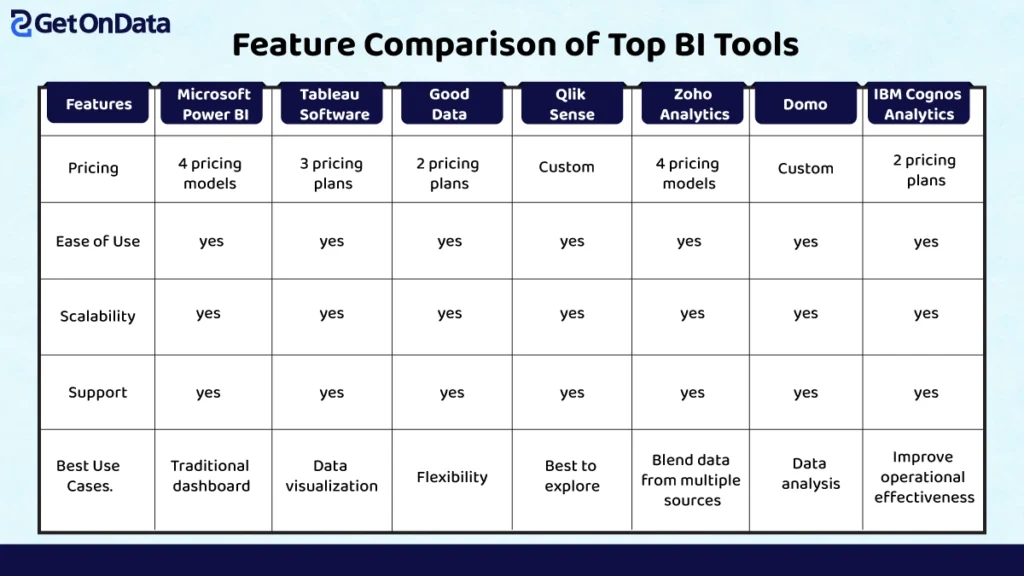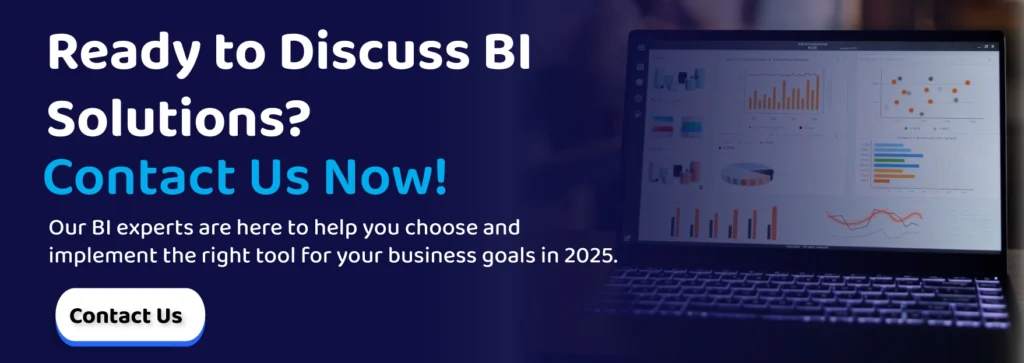BI tools are software apps that gather & analyze the information from vast sources to empower data-driven decision-making. However, the tools have now evolved since they have modern integrated features and functionalities. BI tools offer real-time visibility & predictive analysis for performance & sales forecasting. According to the report,75% of organizations used BI tools by late 2024. The reports estimate that in 2030, the BI market will reach $54.27 billion. BI is the major pillar of success for firms, and that’s the reason why everyone is looking for business intelligence data warehousing.
Understanding Business Intelligence Tools
What are Business Intelligence (BI) Tools?
BI and data warehousing tools are a diverse set of software applications & solutions designed for extracting, transforming & presenting data to support data analysis and strategic decision-making for organizations. The following tools allow for the transformation of raw data into valuable insights, which leads to improved decision-making.
Key Factors to Consider When Choosing a BI Tool
- Ease of Use- Choose the most popular business intelligence tools that have a clear & intuitive user interface and are easy to navigate. Both tech & non-tech users can access this tool.
- The Data Integration- Business intelligence data warehousing tool you choose must align with the present data sources, like cloud platforms, databases & other apps.
- Visualization and Reporting- Pick a tool that enables the creation & sharing of various visualizations that are easy to understand.
- Scalability- Consider how these top business intelligence tools align with your growing user base & data needs.
- Cost- Consider the overall tool cost, which includes a fee for licensing, implementation, and ongoing maintenance.

Top 7 Business Intelligence Tools for 2025
Business intelligence warehousing tools are computer programs that enable data-driven decision-making. They do this by gathering, analyzing, and visualizing data from many sources. Data analyses, interactive visualization of data, performance management, natural language search, and predictive analytics are just a few of the capabilities. Benefits of BI systems include statistical analysis, enabling sales forecasts, and real-time insight into organizational performance. You can also expect fast error detection for a quick response to changes. Here, get AI data warehousing solutions:
1. Microsoft Power BI

Power BI tools used in business intelligence enable you to turn unstructured data into insightful analysis. You can also get dynamic dashboards and reports. Power BI is frequently used by businesses that rely significantly on the Microsoft environment, but it can be difficult to utilize fully since it requires a solid analytical background.
Key Features:
- Interactive dashboards – By commenting on data points, you may work together and share reports. In addition to the default choices, users are able to develop and utilize unique graphics.
- Real-time data analytics: Data transformation, cleansing, and shaping are made possible by Power Query. Power BI enables integration with several Microsoft data sources. Using a drag-and-drop interface, Power BI tools for business intelligence enable you to build data visualizations such as tables, charts, graphs, and maps.
Pros:
- Beginners can easily navigate and use it
- It offers extensive integration with all business tools
Cons:
- Sometimes it can be complicated for extensive data sharing
Also read: Data Visualization In Business Intelligence: How To Make Data Easy To Understand
2. Tableau Software

This is Salesforce’s data visualization tool, along with a business intelligence tool. Tableau is one of the best business intelligence tools that enable analysts to examine, display, and work with data for precise results. It is intended to assist you in converting unprocessed data into easy insights. It is best for data-driven organizations with advanced analytics needs.
Key Features:
- AI-powered insights – Provides access to a range of data warehousing business intelligence, including spreadsheets, databases, cloud-based services, and more. It can help you identify patterns in your data and forecast future events. Give people access to your Tableau dashboards, reports, and visualizations.
- Advanced data visualization – Carries out statistical analysis, predictive modeling, and intricate computations.
Pros:
- Tableau offers you strong visual features that make data analysis easy for beginners.
- Users can get customizable dashboards to set up for their business needs.
Cons:
- Users can learn several things by using this BI tool.
3. GoodData

FlexQuery is the engine behind the AI-driven BI system GoodData. This data service layer is built on Apache Arrow. It is also decomposable. It conducts pre- and post-processing transformations, computes in-memory, and ingests data in batch or real-time.
Key Features:
- Seamless integration with Google products – Seamless integration with Google products helps your business integrate with other tools easily. It offers better customer support that enables your business to reduce downtime.
- Free to use for basic needs – Businesses that are starting can use it for basic needs. It comes free to use and has basic features. Businesses can expect a better and easier user experience & customization.
Pros:
- Budget-friendly– This BI tool is completely budget-friendly and can fit into your budget with some great features
- Intuitive interface– The interface of this tool is immersive, offering a great user experience.
Cons:
- Limited advanced features– The advanced features, compared to other tools, are quite limited in this tool.
4. Qlik Sense

In this BI data warehousing in supply chain management tool, you get Dashboards, bespoke analytics, and built-in analysis. It is a business insight and data visualization tool that enables easy data analysis. Thus, it helps in providing flexibility to accommodate various organizational requirements. It is best for mid and large businesses.
Key Features:
- Robust data discovery – It offers interactive data visualizations, including tables, graphs, and charts. It is well-known for enabling users to investigate hidden relationships through its associative data model. Create and distribute interactive data tales by fusing narrative components with visuals.
- AI-powered analytics- Improve the visualization and analysis of data by utilizing AI capabilities. This BI tool creates a data model using the results of ML experiments you do in the Qlik Cloud Analytics center.
Pros:
- It offers very quick data processing, enabling your business to act and make decisions quickly
- This BI tool is highly customizable & easily personalized
Cons:
- When it comes to cost, this tool can be a little pricey for many businesses.
5. Zoho Analytics

All kinds of businesses can utilize Zoho Analytics. This is because it blends robust BI and analytics features with ease of use. Through visible data pipelines, the platform facilitates smooth data collection and preparation.
Key Features:
- Enterprise-level reporting – It has generative AI features, allowing businesses to use it to generate data for their needs. This tool can also be accessed by non-tech users.
- Advanced analytics– AI feature allows businesses to get precise predictions. It is scalable, which makes it more suitable for small to large businesses.
Pros:
- It is scalable for large businesses, which helps them scale the tool as needed.
- You can expect Secure data management for your business.
Cons:
- This tool has a very complex setup that requires thorough training before starting.
6. Domo

Domo is a platform for business intelligence that offers data gathering resources. It helps by displaying and evaluating data from many sources. It supports a data-driven decision-making facility. It is best for Organizations looking for cloud-based BI.
Key Features:
- Built-in apps and connectors- A wide range of users may access it thanks to its compatibility with well-known iOS and Android mobile apps. Provides a variety of reporting options along with a drag-and-drop function for content production and ad hoc analysis.
- Cloud-based solution– Features a cloud-native design that includes significantly parallel processing (MPP) and dynamic scalability. The planned content is all included in the collaboration capabilities.
Pros:
- This BI tool offers easy data sharing and collaboration across platforms.
- It offers strong mobile support, allowing users to access it from anywhere.
Cons:
- This BI tool can be expensive for small businesses.
7. IBM Cognos Analytics

Designed for bigger installations, IBM Cognos is a feature-rich business intelligence package. In addition to capabilities for dashboards, full-text search, and Microsoft Office connectivity are its advanced features. This is best for businesses needing custom analytics solutions.
Key Features:
- Embedded analytics– The embedded analytics allow users to save time when gathering data from multiple sources.
- Scalable architecture– This helps businesses to scale the tool when their business grows.
Pros:
- Flexible data integration allows businesses to easily integrate it with other tools.
- High-performance analytics helps businesses to make precise data-driven decisions
Cons:
- Using this tool requires technical expertise.
Also read: Business Intelligence: A Comprehensive Guide
Comparative Analysis of the Top BI Tools
Table: Feature Comparison of Top BI Tools

How to Choose the Right BI Tool for Your Business?
Identify Your Business Needs:
When looking for a business intelligence tools list, make sure it is easy for both tech & non-tech users. The tools must have an easy dashboard/interface with advanced analytics features.
Evaluate Your Budget:
The pricing structure of BI tools should be checked. The plans can vary from user subscriptions to on-premise deployment. Consider your business requirements and choose your plan accordingly.
Consider Integration Requirements:
BI tools should be easily integrated with any 3rd party tools. This not only improves collaboration but also generates and cultivates a data culture. It drives business success.
Test with Free Trials:
Make sure the tools offer free test facilities. Free trials give confidence to invest in specific tools that align with your business needs.

Ready to Choose the Perfect BI Tool for 2025? We Can Help!
In conclusion, now you know what are business intelligence tools. Selecting the ideal BI tool for the organization is necessary for data-driven success. Align the tool you choose with your business needs, size & budget. If you want expert help, talk with the business intelligence warehousing experts.
